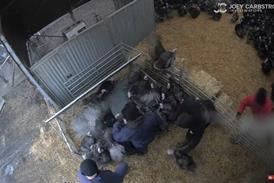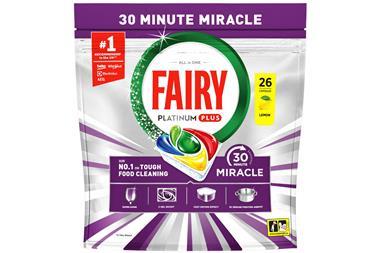…for Wal-Mart, but is the industry ready for RFID, asks Siân Harrington
As 200 suppliers wait to hear next month what Wal-Mart expects of them in the next phase of its radio frequency identification (RFID) deployment and another band of suppliers get ready for the first phase of Tesco’s implementation of radio barcoding this September, new research shows cost is still the major barrier to the wider adoption of this new technology.
IGD has surveyed retailers and suppliers on their views on whether RFID is the next big thing for the industry. The full survey findings will be unveiled at the end of June but a snapshot obtained by The Grocer gives a flavour of what the industry thinks. And the message is mixed.
More than two-thirds of respondents (68%) believe RFID will deliver benefits for the industry but it is clear that cost and the lack of international standards are hindering its take-up. In particular, much importance is attached to return on investment.
The problem lies in quantifying the true cost of implementing an RFID tag. As some manufacturers point out, if all their major customers fail to adopt the technology, it will be difficult to unlock the full benefits of the supply chain.
This view was echoed by Chris Tyas, Nestlé UK and Ireland group director of supply chain and IS, at the EPCglobal conference in London last month.
“Most benefits of RFID come by taking an integrated, end-to-end view of the supply chain. The manufacturer’s case in isolation looks weaker than the retailer’s, and weaker still if RFID is only adopted by a few retailers,” Tyas said.
Despite widespread hype about the technology, fewer than four in 10 supplier respondents have been approached by a trading partner to undertake RFID. In the UK Tesco, Asda and Marks and Spencer have approached them, while outside the country it appears that Wal-Mart and Metro are leading the way.
More than a third (35%) of respondents plan to implement RFID to satisfy these retail customers, but a fifth are undecided. And only 4% think RFID will be widespread in two years, with 65% saying it could take between three and five years. This is because it will take this time for the technology costs to reduce, for standards for the tag to be fully adopted and for the technology to be fully tested in a live trading environment.
Interestingly, only one third of respondents are confident RFID will be the answer to availability – the issue that dominates the agenda for most businesses. A further 33% believe it will not solve this issue, while the final third are not sure at this stage.
But 63% do feel RFID will benefit the consumer, with advances such as automated payment systems in store, which will eradicate the need for queuing. However, it will be important for retailers to communicate how and why they are using RFID and what it means for their customers.
Joanne Denney-Finch, chief executive of IGD, says RFID has great potential, but experience shows every technology has its own teething problems.
“We now need to bridge the gap between pilot testing and mass application. I think we can guarantee it won’t always go smoothly, but with perseverance RFID will start to transform the supply chain.”
RFID – The Next Big Thing will be available at the end of June (see www.igd.com). Also see the Supply IT supplement free with this issue.
Benefits of RFID
>>Identified by respondents
1 – Great speed and efficiency in operation
This will be in areas such as booking stock in, stock-taking, scanning stock out and receiving proof of delivery. Compared with the manual processes now in place, the savings could be significant.
2 – Tracking products throughout the chain
The ability to track products will be particularly useful when issues such as product recalls arise, where a particular batch of product can be immediately identified in any part of the supply chain.
3 – Enhanced forecasting
Retailers and suppliers will be able to benefit through enhanced forecasting. This will be achieved through the ability to access greater aspects of a product’s movement throughout the chain, for example checking availability in the store.
As 200 suppliers wait to hear next month what Wal-Mart expects of them in the next phase of its radio frequency identification (RFID) deployment and another band of suppliers get ready for the first phase of Tesco’s implementation of radio barcoding this September, new research shows cost is still the major barrier to the wider adoption of this new technology.
IGD has surveyed retailers and suppliers on their views on whether RFID is the next big thing for the industry. The full survey findings will be unveiled at the end of June but a snapshot obtained by The Grocer gives a flavour of what the industry thinks. And the message is mixed.
More than two-thirds of respondents (68%) believe RFID will deliver benefits for the industry but it is clear that cost and the lack of international standards are hindering its take-up. In particular, much importance is attached to return on investment.
The problem lies in quantifying the true cost of implementing an RFID tag. As some manufacturers point out, if all their major customers fail to adopt the technology, it will be difficult to unlock the full benefits of the supply chain.
This view was echoed by Chris Tyas, Nestlé UK and Ireland group director of supply chain and IS, at the EPCglobal conference in London last month.
“Most benefits of RFID come by taking an integrated, end-to-end view of the supply chain. The manufacturer’s case in isolation looks weaker than the retailer’s, and weaker still if RFID is only adopted by a few retailers,” Tyas said.
Despite widespread hype about the technology, fewer than four in 10 supplier respondents have been approached by a trading partner to undertake RFID. In the UK Tesco, Asda and Marks and Spencer have approached them, while outside the country it appears that Wal-Mart and Metro are leading the way.
More than a third (35%) of respondents plan to implement RFID to satisfy these retail customers, but a fifth are undecided. And only 4% think RFID will be widespread in two years, with 65% saying it could take between three and five years. This is because it will take this time for the technology costs to reduce, for standards for the tag to be fully adopted and for the technology to be fully tested in a live trading environment.
Interestingly, only one third of respondents are confident RFID will be the answer to availability – the issue that dominates the agenda for most businesses. A further 33% believe it will not solve this issue, while the final third are not sure at this stage.
But 63% do feel RFID will benefit the consumer, with advances such as automated payment systems in store, which will eradicate the need for queuing. However, it will be important for retailers to communicate how and why they are using RFID and what it means for their customers.
Joanne Denney-Finch, chief executive of IGD, says RFID has great potential, but experience shows every technology has its own teething problems.
“We now need to bridge the gap between pilot testing and mass application. I think we can guarantee it won’t always go smoothly, but with perseverance RFID will start to transform the supply chain.”
RFID – The Next Big Thing will be available at the end of June (see www.igd.com). Also see the Supply IT supplement free with this issue.
Benefits of RFID
>>Identified by respondents
1 – Great speed and efficiency in operation
This will be in areas such as booking stock in, stock-taking, scanning stock out and receiving proof of delivery. Compared with the manual processes now in place, the savings could be significant.
2 – Tracking products throughout the chain
The ability to track products will be particularly useful when issues such as product recalls arise, where a particular batch of product can be immediately identified in any part of the supply chain.
3 – Enhanced forecasting
Retailers and suppliers will be able to benefit through enhanced forecasting. This will be achieved through the ability to access greater aspects of a product’s movement throughout the chain, for example checking availability in the store.















No comments yet